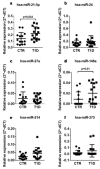Serum Levels of miR-148a and miR-21-5p Are Increased in Type 1 Diabetic Patients and Correlated with Markers of Bone Strength and Metabolism
- PMID: 30486455
- PMCID: PMC6315714
- DOI: 10.3390/ncrna4040037
Serum Levels of miR-148a and miR-21-5p Are Increased in Type 1 Diabetic Patients and Correlated with Markers of Bone Strength and Metabolism
Abstract
Type 1 diabetes (T1D) is characterized by bone loss and altered bone remodeling, resulting into reduction of bone mineral density (BMD) and increased risk of fractures. Identification of specific biomarkers and/or causative factors of diabetic bone fragility is of fundamental importance for an early detection of such alterations and to envisage appropriate therapeutic interventions. MicroRNAs (miRNAs) are small non-coding RNAs which negatively regulate genes expression. Of note, miRNAs can be secreted in biological fluids through their association with different cellular components and, in such context, they may represent both candidate biomarkers and/or mediators of bone metabolism alterations. Here, we aimed at identifying miRNAs differentially expressed in serum of T1D patients and potentially involved in bone loss in type 1 diabetes. We selected six miRNAs previously associated with T1D and bone metabolism: miR-21; miR-24; miR-27a; miR-148a; miR-214; and miR-375. Selected miRNAs were analyzed in sera of 15 T1D patients (age: 33.57 ± 8.17; BMI: 21.4 ± 1.65) and 14 non-diabetic subjects (age: 31.7 ± 8.2; BMI: 24.6 ± 4.34). Calcium, osteocalcin, parathormone (PTH), bone ALkaline Phoshatase (bALP), and Vitamin D (VitD) as well as main parameters of bone health were measured in each patient. We observed an increased expression of miR-148a (p = 0.012) and miR-21-5p (p = 0.034) in sera of T1D patients vs non-diabetic subjects. The correlation analysis between miRNAs expression and the main parameters of bone metabolism, showed a correlation between miR-148a and Bone Mineral Density (BMD) total body (TB) values (p = 0.042) and PTH circulating levels (p = 0.033) and the association of miR-21-5p to Bone Mineral Content-Femur (BMC-FEM). Finally, miR-148a and miR-21-5p target genes prediction analysis revealed several factors involved in bone development and remodeling, such as MAFB, WNT1, TGFB2, STAT3, or PDCD4, and the co-modulation of common pathways involved in bone homeostasis thus potentially assigning a role to both miR-148a and miR-21-5p in bone metabolism alterations. In conclusion, these results lead us to hypothesize a potential role for miR-148a and miR-21-5p in bone remodeling, thus representing potential biomarkers of bone fragility in T1D.
Keywords: bone metabolism; circulating microRNAs; miR-148a; type 1 diabetes.
Conflict of interest statement
The authors declare no conflict of interest.
Figures



References
-
- Weber D.R., Haynes K., Leonard M.B., Willi S.M., Denburg M.R. Type 1 diabetes is associated with an increased risk of fracture across the life span: A population-based cohort study using The Health Improvement Network (THIN) Diabetes Care. 2015;38:1913–1920. doi: 10.2337/dc15-0783. - DOI - PMC - PubMed
-
- Eller-Vainicher C., Zhukouskaya V.V., Tolkachev Y.V., Koritko S.S., Cairoli E., Grossi E., Beck-Peccoz P., Chiodini I., Shepelkevich A.P. Low bone mineral density and its predictors in type 1 diabetic patients evaluated by the classic statistics and artificial neural network analysis. Diabetes Care. 2011;34:2186–2191. doi: 10.2337/dc11-0764. - DOI - PMC - PubMed
-
- Bonds D.E., Larson J.C., Schwartz A.V., Strotmeyer E.S., Robbins J., Rodriguez B.L., Johnson K.C., Margolis K.L. Risk of fracture in women with type 2 diabetes: The Women’s Health Initiative Observational Study. J. Clin. Endocrinol. Metab. 2006;91:3404–3410. doi: 10.1210/jc.2006-0614. - DOI - PubMed
Grants and funding
LinkOut - more resources
Full Text Sources
Miscellaneous

